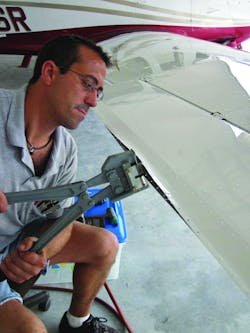Airframe Technology: Repair on Thin Skinned Aircraft
Sheet metal fabrication is considered a blend of art and science, requiring finesse to achieve desirable results. Sometimes the experience to achieve the desirable results can be costly.
If you have ever worked with aircraft sheet metal you have undoubtedly done something to that metal and then noticed that it had an unexpected effect somewhere else. Getting unwanted shrinking and stretching where you didn’t intend is a costly and time consuming mistake. The ability to straighten thin skin before riveting can make all of the difference to achieve a professional result.
One of the more common hand operated forming tools is the shrinker–stretcher. This may be one of the first metal forming tools you get to use, but you may not fully understand its operation. It works by applying tremendous pressure on dies that grab the surface of the metal to push the metal together or apart.
Always practice first on a scrap piece of metal the same thickness and temper as the aircraft skin being repaired in order to learn how the jaws will affect the material. Over time, the jaws become clogged with aluminum dust and do not grab the same way as they did the last time they were used. It’s a good idea to keep clean the jaws with a file card, not a wire wheel, and remove material build up in the textured surface. After cleaning and testing on scrap material of the same thickness you are using, you’re ready to do some shrinking or stretching.
Hangar rash is common on aircraft, both fixed wing and rotary wing alike. They are both built from the same thin aluminum skins and difficult to work with. Often times you will find metal on an aircraft has been bent and subsequently stretched. If you take a hammer and dolly trying to straighten this you will just be chasing your tail. You may reach for the steel hammer next but hitting the metal will probably stretch it even more. In this case the metal needs to be shrunk not stretched.
The correct process is to take the part or metal over to the vice where the shrinker is located. But what if this damage is on the horizontal stabilizer of a general aviation aircraft and removal from the aircraft to facilitate bench work is labor intensive and costly? The vise-mounted shrinker-stretcher has been around for a long time and the value is undeniable. However, it was designed to be strong, heavy, immovable, and cumbersome.
The right tool for the right job
When initially looking for the right shrinker-stretcher tools for my shop I became frustrated. While tools were available I felt they were heavy in terms of weight and cost. The cost of acquisition now exceeds some $7,000 when buying all the required tooling. I felt a better tool was needed for specialized spot repairs so I set out to design and build my own tool which I call the “MinimizerTM” shrinker-stretcher. The hand held shrinker-stretcher is a fraction of the cost, much lighter and easier to use, hand crafted in the USA, cadmium plated, about half the weight, and uses the same interchangeable dies that fit in a standard shrinker.
“The right tool for the right job,” I remember these words from A&P school. After you have the right tool you need to be able to use it properly. This does not start with the tool, but with studying both the metal and the damage you want to repair.
My method is to mark the high spots with a pencil on the stretched material. This is where you will use the tool and center the jaws. Smaller shrinks over a larger area is much better than a large shrink in one area which results in buckling the skin. This is difficult to remove and might crack the skin; either way buckling the skin makes the job much harder. Using the small shrink method will get the metal to lay straight. Push on the aluminum to see if it wants to spring back. If it does spring back you may need a small shrink or two in the right place to remove the “oil canning.”
Using this process not all of the shrink lines need to be in the same plane, and they can be varied 45 degrees to break up the lines and remove the shrink marks. It is also better to regularly study the damage and the effect that you are having on the aluminum rather than go too far and buckle the skin. Trying to stretch metal that is already stressed with lines stamped in the surface can very easily result in a crack in the skin. It’s best to proceed slowly with caution.
Take your time
Let’s say this takes care of the damage on the left side of the stabilizer, but what about the crack and the stop drilled hole on the right side? A typical example is a crack that also happened from being over stressed sometime in the past with a pair of pliers or wrench used to remove the elevator hinge bolts. If you want to make a flush repair that looks nice you may have a dilemma. This skin is too thin to use flush rivets, so dimpling will serve the purpose but some shrinking may be required for the skin to lay flat. Dimpling also shrinks the material even more but it also adds rigidity to the repair.
If you spend a little time to consider the known elements of a repair before forging ahead, then you will be less likely to paint yourself into a corner because you were rushing. When using any shrinker-stretcher designed for thin metals it’s important to check that it is adjusted properly. In the case of the Minimizer this is done by loosening up the lock nuts on the eccentric bolts and moving them until both edges of the beveled blade edges are parallel and touching. This adjustment will insure that the pressure on the dies is equal which is important on thin metal. The more that you cold-work the material the harder it gets, so try to complete your shaping or repairs in as few moves as possible.
Hopefully I’ve been able to provide you a few new ideas to achieve better results the next time you have a thin sheet metal repair or fabrication job. Make it fun and be creative, but above all make it as easy as possible by thinking the job through first and then use the right tools.
Don’t be afraid to ask questions and to share knowledge because we are all interdependent upon one another. Be proud to learn something new everyday as our industry is a learning process that never stops!
About the author
Robert Behrend holds and A&P and IA. He founded his business Aerostructures of the Palm Beaches Inc. in 2003 which specializes in structural repair work on corporate use and general aviation aircraft, government prototype design, and commercial use aircraft. Robert graduated from Teterboro School of Aeronautics and has 25 years experience in the aeronautics engineering and fabrication business. For more information visit www.metalminimizer.com

